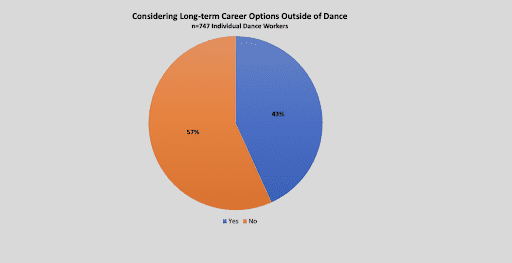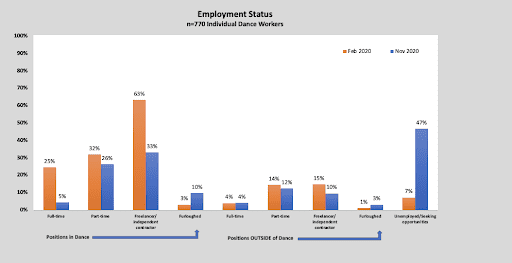DATA ON INDEPENDENT DANCE WORKERS
Page Updated July 27th, 2021 2:00 p.m.
AT A GLANCE
- Survey data is the second phase of a follow-up to the Spring 2020 survey launched at the outset of the pandemic.
- 135 valid survey responses from independent dance workers between November 2020 and May 2021.
- 84% of respondents identify as dancers
- Average total income of respondents dropped from $35,093 in 2019 to $26,423 in 2020.
- At $28,669, anticipated 2021 income per respondent is slightly higher than 2020 levels as restrictions loosen and activity resumes.
- 37% of independent dance workers are unemployed, as compared to 47% in November 2020
TOP KEY TAKEAWAYS (As of February 15, 2021)
Independent dance workers are slowly getting back to work on indoor and outdoor programming:
- 46% are scheduled to work on programming this summer
- 64% of those who are engaged to work this summer will work on outdoor performance, 53% will work on indoor performance
- 36% do not expect to be paid a living wage for this work and 27% aren’t sure yet if they will be paid a living wage
Decreasing levels of dance workers need unrestricted funds for housing/food while the need for salaries/wages remains consistent. and the need for mental health care and IT resources has increased.
- 29% need funds for housing (a 43% drop since November 2020)
- 45% need funds for food/groceries (a 24% drop since November 2020)
- 69% need salaries/wages
- 41% need access to mental health care (as compared to 35% in November 2020 and 24% in Spring 2020)
- 29% need IT and Tech equipment resources (as compared to 24% in November 2020)
Independent dance workers have worked to access work and funds:
- 75% have filed for unemployment
- 66% have earned income from remote work and did NOT do this work remotely before COVID-19
- 44% applied for relief grants from various sources; those who were granted funds received an average of $2,213
The crisis is shifting the size and makeup of the field:
- 46% of dance workers are now employed full-time, part-time or freelance outside of the dance field as compared to 33% in Fall 2020.
- 37% are unemployed as compared to 47% in Fall 2020 and 7% unemployed at the beginning of the pandemic
- 5% have permanently relocated and another 15% are considering permanent relocation
- 49% are considering long-term career options outside of dance as compared to 43% in Fall 2020.


Survey responses reveal disproportionate needs and impacts for dance workers who identify as disabled, ALAANA, as well as older dance workers, immigrant dance workers and those living in the Bronx. Specifically:
- 21% of African, Latina/o/x, Asian, Arab, and Native American (ALAANA) dance workers were unable to pay rent/mortgage in October 2020 as compared to 15% of White (non-Hispanic) dance workers
- 49% of African, Latina/o/x, Asian, Arab, and Native American (ALAANA) dance workers need food/groceries as compared to 36% of White (non-Hispanic) dance workers
- 54% of immigrant dance workers need medical health care coverage as compared to 32% of those born in the US
- Disabled dance workers lost 29% of their annual income while nondisabled dance workers lost 25%
- Individual dance workers living in the Bronx have more critical needs than those living in other places, identifying 5 out of 11 needs at higher levels. Those needs include cleaning equipment and supplies, mental health care, transportation and personal care.
Individual dance workers lost an average of 36% of their income ($11,678) between 2019 and 2020, or double what they anticipated losing when surveyed in Spring 2020. Dance makers experiencing these levels of financial loss were well-distributed throughout the City. Data from Fall 2020 suggested that about 44% applied for relief grants. More than 200 individual dance workers were awarded relief grants from sources other than Dance/NYC, receiving an average of $2,213 or 19% of the average loss. More recent data shows that dance workers anticipate a slight increase in average income for 2021 over 2020 though income will still remain well below pre-pandemic levels.
WORKFORCE DISPLACEMENT
In Spring 2020, 7% of survey respondents noted that they had recently relocated, with most leaving the City to stay with family and “escape the virus.” Additional respondents were considering leaving shortly.
In Spring 2021, at least 5% of respondents had relocated permanently and 15% had left for the time being with the hope of returning. An additional 13% had left and already returned.
This migration is evident in the geographic distribution of survey respondents in Spring 2020 vs Fall 2020. Shifts primarily took place out of Manhattan and Brooklyn and into areas outside of the New York City region.
Even still, 15% of respondents are considering permanently relocating and 17% are considering temporary relocation due to lack of work and income. And 49% of respondents are considering career options outside of dance.
FINANCIAL IMPACT (as of February 15, 2021)
Individual dance workers report a cumulative loss of at least $4.7M in income related to 6,100+ canceled dancer performances, 12,100+ canceled rehearsals, 8,500+ canceled teaching engagements, 2,100+ canceled commissions, and 3,200+ other engagements. These figures are largely understated given the unknown timeline of social distancing mandates.
NOTABLE IMPACTS BY IDENTITY CATEGORY
Segmentation analysis by identity category and location show that the crisis continues to disproportionately impact people who identify as disabled, ALAANA, genderqueer/nonbinary as well as older dance workers.
The average annual financial loss for survey respondents is $8,670, yet:
- Disabled dance workers report a 29% decrease in annual income as compared to 25% for nondisabled dance workers
- Dance workers who identify as ALAANA report a 28% decrease in annual income as compared to 24% for white respondents.
The critical needs of these identity groups differ as well:
- More disabled dance workers need funding for mental health care (43% vs 41% for non-disabled workers), transportation (43% vs 26% for non-disabled dance workers) and personal care (29% vs 22% for non-disabled dance workers.)
- More ALAANA dance workers need food and groceries (49% vs 36% for White (non-Hispanic) dance workers, IT/Tech equipment resources (35% vs 19% for White (non-Hispanic) dance workers) and personal care (43% vs 5% for White (non-Hispanic dance workers.)
- More immigrant dance workers need medical health care (54% vs 32% for dance workers born in the US), mortgage/rent (77% vs 46% for dance workers born in the US) and personal care (31% vs 22% for dance workers born in the US.)
RESPONDENT POOL: DEMOGRAPHIC INFORMATION
Survey respondents are concentrated in North Brooklyn, Queens and Upper Manhattan. In Queens, dozens of survey respondents in close proximity to some of the areas with highest concentrations of Covid-19 diagnoses since March 2020.


Log in to comment